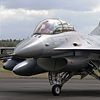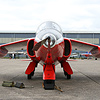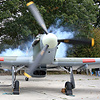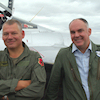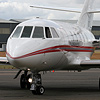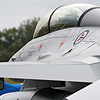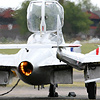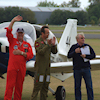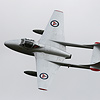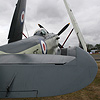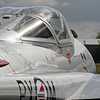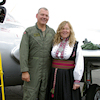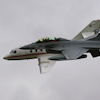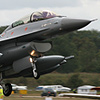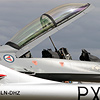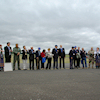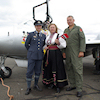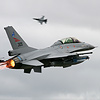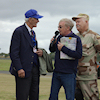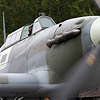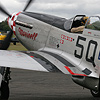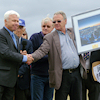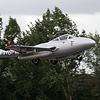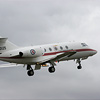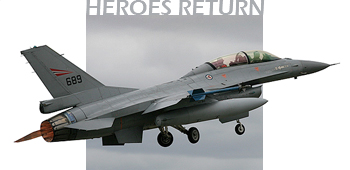
North Weald Community Day Fly-In 2009 Review
Sunday 13th September
Between 1942 and 1944, 331 and 332 Norwegian Squadrons operated Spitfires from what was then RAF North Weald. In 2009, the Royal Norwegian Air Force celebrated their 65th anniversary and to mark the occasion, 331 and 332 Squadrons past and present were represented when they returned to their former wartime home in Essex for a community fly-in event, held on the September 13th. Arriving on the Friday prior were a pair of 132 Wing F-16BMs, and more significantly, a RNoAF Falcon 20, which brought six Norwegian veterans back to North Weald, to make an emotional return to the airfield from which they flew combat missions during the war. The day was a mixture of commemoration and celebration, with a wreath laid at the airfield memorial in honour of the thirty-six Norwegian pilots who were killed flying from the airfield during the Second World War. The friendship between North Weald Basset and the Norwegian city of Bodø, the current base of 331 and 332 squadrons, was celebrated.
and report from Essex. Additional photography by
The airfield opened to visiting aircraft and the public alike at 9am, followed an hour later by the "community area display", which featured ground based attractions including Fire and Rescue demonstrations, Vintage Cars, re-enactment groups and RC model flying. The entry fee for the day was a reasonable £3, with proceeds going to the Royal Air Force Association Wings Appeal. A number of North Weald's resident aircraft had been lined up outside their respective hangars for close inspection, without any barriers. Some of the more interesting aircraft on static display included Bell UH-1H G-HUEY, a twosome from Kennet Aviation with the Seafire and Skyraider, two Jet Provosts from Swords Aviation, a Strikemaster, the Gnat Display Team's duo, a Harvard and Boeing Stearman. The DC-4 and C-54 Skymasters were also accessible. Aircraft flying in during the morning included Maurice Hammond's Harvard, Nigel Willson in his Yak 52 and the Essex and Metropolitan Police helicopters. Hangar 11's "Hurribomber" was also outside the collection's hangar, being prepared for her owner, Peter Teichman, to take her for a flight later in the day.
Also parked on the ramp were a pair of de Havilland Vampires. The Vampire Preservation Group were present with their resident T11, WZ507, and Kenneth Aarkvisla's T55 LN-DHZ had flown in to North Weald non-stop from Norway to join them. Arriving on the Thursday, the flight took an hour and 55 minutes and meant that both Norway's first and most recent jet fighter types were present for the celebrations. The aircraft itself is probably familiar to airshow goers in this country; formerly registered as G-DHZZ, she was flown on the UK airshow scene during the 1990s by the Source Classic Jet Flight in a 56 Squadron colour scheme. After a period of storage at Bournemouth, Kenneth purchased the aircraft a couple of years a go. Now residing at Sandefjord Torp along with the Norway Dakota (which itself has been seen recently on these shores when it appeared at Duxford Flying Legends in 2006) the Vampire has had a full repaint to Royal Norwegian Air Force markings. Completing the line-up on the ground, the Royal Air Force were present and represented by a single a Tucano from 72 (R) Squadron.
This wasn't the first time that the Royal Norwegian Air Force have visited North Weald in modern times. Most recently, a pair of F-16s were present for the airfields 90th anniversary in 2006, and the goodwill visits go back as far as 1955, when 331 and 332 Squadrons returned in F-84G Thunderjets.
Originally formed in July 1941 as a fighter unit, 331 Squadron initially flew ex-Polish Hurricane Mk 1's after standing up at RAF Catterick in Yorkshire. The association with North Weald began a few months later, when they moved to Essex in May of 1942, by which time they were already flying Spitfires Vb's with the squadron code of "FN", believed to an abbreviation for "First Norwegian". During their time at North Weald, 331 Squadron were involved in several significant battles of the time, flying as part of the Allied attack on the German-occupied port of Dieppe as well as acting as fighter bombers in support of the Normandy Landings and later flying escort missions over northern France.
332 Squadron, also flying Spitfires, joined 331 at North Weald during 1942 to form the North Weald Wing, later becoming 132 Wing; a title they still hold to this day at Bodø Main Air Station. After hostilities had ended, 331 and 332 returned to Norway, but it wasn't until late 1945 that the two Squadrons disbanded as RAF units and were passed into the control of the Royal Norwegian Air Force. Interestingly, the Grace Spitfire, ML407, served with 332 Squadron during their involvement with ground attack operations in the liberation of the Netherlands in 1944. Although the unit were no longer based at North Weald during ML407's service with 332, it was nevertheless a shame that this Norwegian veteran couldn't have been present to mark the occasion.
Between them, Nos 331 and 332 Squadrons claimed 196 aircraft destroyed, 35 probables and 123 damaged during the European conflict, while their own losses were 131 aircraft and 71 pilots.
Returning to the events of 2009, Peter Teichman took off to perform in his Hurricane Mk IIb just before noon, and swiftly went into his usual graceful display before vacating. He returned a short while later, escorting Maurice Hammond and his P-51D Mustang "Marinell". These two aircraft are the most recently restored examples of their respective types and this was the first time they'd been seen in the air together.
During the early afternoon the six Norwegian veterans - Rolf Mutzfelot Kolling, Lt General Wilhein Mohr, Trygve Woxen, Rangvald Myhre, Inge Ovstedal and Inge Sandvik - were shown around the Vampires and F-16s before they were formally introduced to the sizeable crowd that had gathered outside 'The Squadron Club' - the nucleus of contemporary operations at North Weald, with bar and restaurant facilities as well as support services for aircraft operations.
Trygve Woxen, 91, gave a brief interview whilst the crowd stood listening to him in respectful silence, in which he recalled operations he flew from the airfield during 1943. Predominantly ground attack missions, known as RUHBARBS, these involved a pair of Spitfires attacking ground targets. Remarkably, Trygve managed to survive 201 sorties and was a part of the D-Day invasion. Although eventually shot down over the Netherlands, he managed to evade the enemy and make it back to his forward station. Rolf Mutzfelot Kolling, also a part of the D-Day invasion, managed to avoid being shot down but did make a forced landing in Normandy. Returning onboard a DC-3 with soldiers wounded in the Normandy landings, he rejoined the squadron, flying another Spitfire.
The current commanding officer of 132 Wing explained the strength of the relationship with North Weald to the audience, before a short ceremony to celebrate the relationship between North Weald Basset and Bodø, with local dignitaries from the two villages making speeches and exchanging gifts. The veterans then headed back to "The Squadron" building, met by a warm round of applause from the crowd.
Also interviewed were the recent winning Schneider Trophy pilots; North Weald aircraft came a record first, second and third in the historic event that was held just a week earlier, on the September 6th. Neil Cooper and Andrew Keywood came first in Bulldog G-JWCM (Race 44), second were Roger Hayes and Andrew Lucas in Bulldog G-BCUS (Race 121), and third Craig Beevers and Alistair Allen in SF260 N61FD (Race 1). Neil was also second in the Saturday race for the Rolls Royce Merlin Trophy. Trevor Jago and Ian Cooper (Neil's father) then led the special Schneider formation fly past of the three winning aircraft. Roger Hayes and Andrew Lucas flew as the Number 2 and Alistair Allen in N61FD was Number 3 in the formation. By coincidence this date in 1931 was when the Supermarine S6B clinched the trophy for Britain.
Before long it was time for the veterans to head home to Norway. As they boarded the Falcon 20, the BBMF's Spitfire XIX and Hurricane IIc appeared overhead with their famous to-the-second timing, performing three fly-pasts before heading back to RAF Coningsby. After a short pause, waiting for air traffic clearance in the busy London skies, the Falcon 20 took off. Ken Ellis, who was commentating on the day's proceedings, pointed out to the crowd that this was likely to be the last time the six veterans took off from North Weald. A poignant moment. The Falcon 20 flew one circuit of the airfield, banking left so the veterans onboard could see the crowd waving them off. The F-16 pair then performed full power departures, the afterburners melting the runway as they went! They escorted the Falcon 20 for one final pass of the airfield, joined at the rear of the formation by Kenneth Aarkvisla in his Vampire. Kenneth then performed a number of fly-pasts in his Vampire before Mark Hooton joined him in the VPG's WZ507. Again, this was another noteworthy formation as it was the first time in many years that two Vampires had been seen in the skies together in this country. The Vampire landings marked the end of the event.
Organised by 'The Squadron Club' (North Weald Flying Services) and Epping Forest District Council, it was hoped that the day would be the first of a series of events to honour the squadrons from six nations that formerly flew operations from RAF North Weald.
This first event in the series specifically aimed to highlight the special friendship between North Weald Basset and Bodø, and to entice the next generation of both communities to continue this friendship. The evidence seen during the day suggests it was very much mission accomplished. A sizeable donation was also made to the RAFA Wings Appeal. We eagerly anticipate next years second installment.

